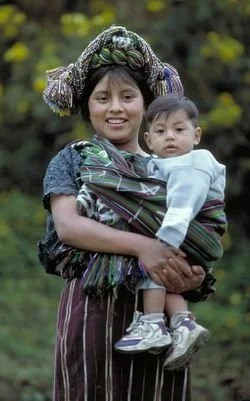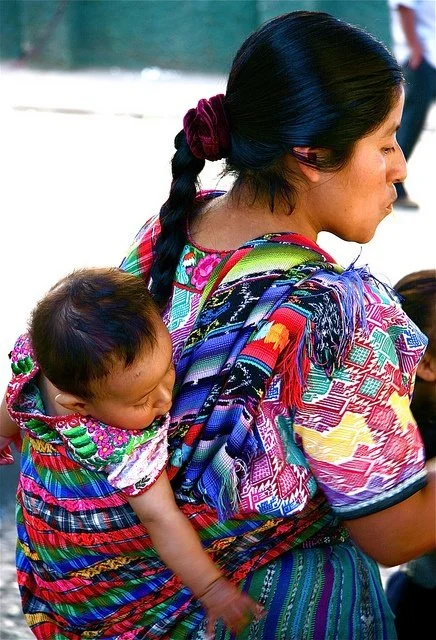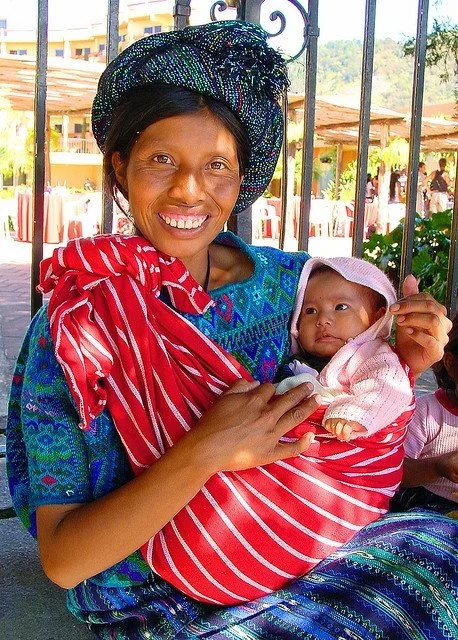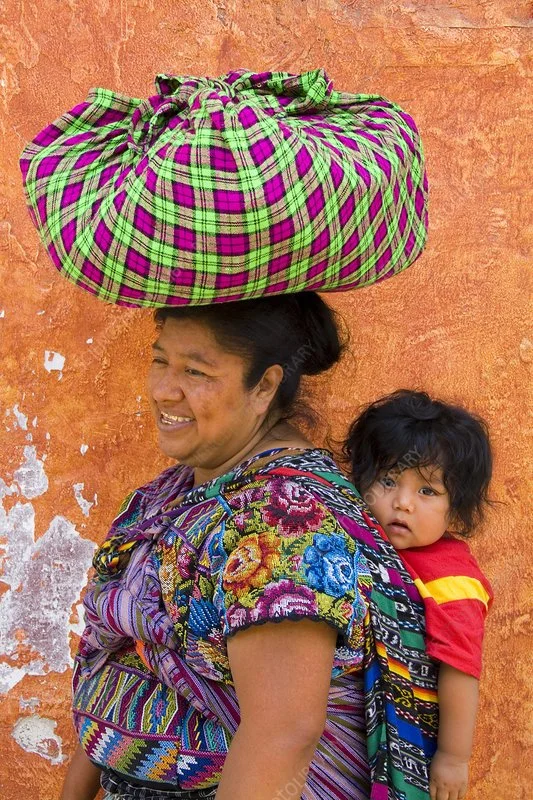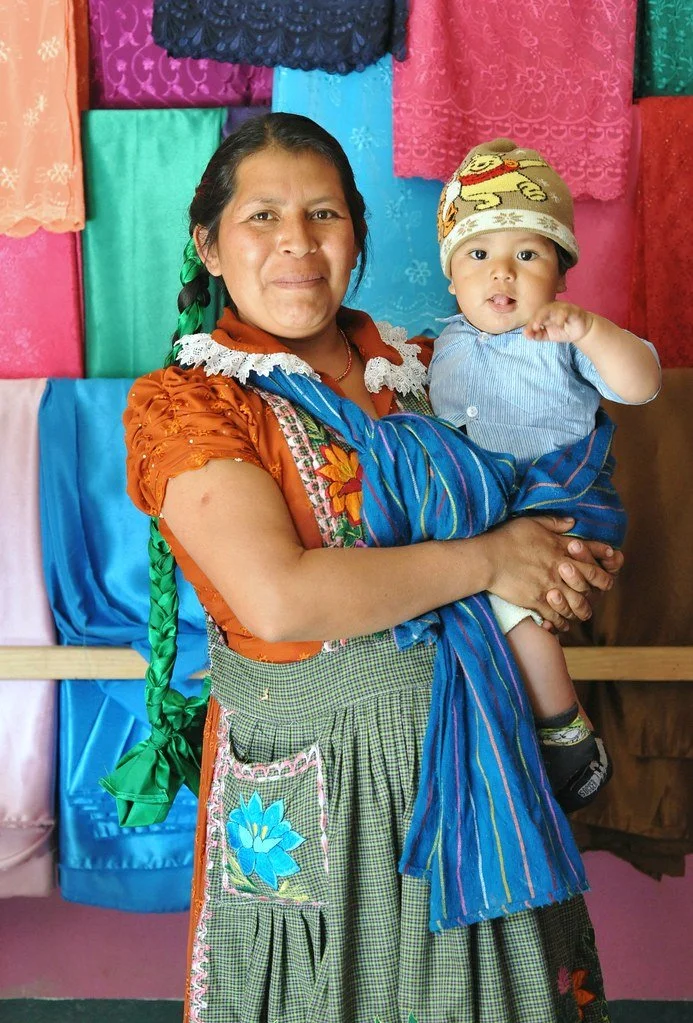Mesoamerica: Rebozos, Tzutes, and Living Weaves
In Mesoamerica — a cultural region encompassing present-day southern Mexico, Guatemala, Belize, and parts of Honduras and El Salvador — babywearing is inseparable from the rich textile traditions, communal life, and enduring resistance of the Indigenous peoples who have always called this land home. Among the Maya, Zapotec, Mixtec, and many other nations, carrying a baby is an act of love, belonging, and resilience that weaves each new generation into the living story of their people.
The rebozo, a long handwoven cloth, is central to caregiving across many Indigenous and mestizo communities in Mexico. Mothers wrap their babies to their fronts, hips, or backs, keeping them close while participating fully in daily life — from tending markets and fields to preparing food and taking part in community ceremonies. The rebozo is far more than a practical tool; it is a symbol of feminine strength and continuity, often passed down through generations and used in blessings, births, and other sacred moments.
In Guatemala, tzutes — versatile woven cloths — serve a similar role. Each cloth carries its own story through intricate patterns and colors, often linked to a particular village, family lineage, or set of ancestral beliefs. Babies carried in tzutes are wrapped in warmth and security, immersed in the sights, sounds, and languages of their people from their very first days.
Weaving itself is a sacred act, carried out on backstrap looms that have been used for centuries. Each design holds spiritual significance, with symbols for protection, fertility, and connection to the land woven into every thread. In this way, each carrier becomes a prayer for the baby’s future and a tangible expression of collective memory.
Despite centuries of colonization and ongoing attempts to erase Indigenous cultures, these carrying traditions persist and flourish as powerful acts of cultural pride and continuity.
To be carried in Mesoamerica is to be woven into the very fabric of family and land — a moving tapestry that affirms each child’s place within an unbroken chain of ancestors, stories, and sacred relationships to the earth.
Nahua (Aztec descendants)
The Nahua people are the largest Indigenous group in Mexico today, primarily living in central Mexico, including the states of Puebla, Veracruz, Hidalgo, and Morelos. Traditionally, Nahua mothers carry their babies in a rebozo, a long rectangular woven cloth used to secure the baby on the back or front. The rebozo is multifunctional, deeply symbolic, and often beautifully patterned — it signifies care, tradition, and community ties.
Maya
Maya communities are spread across southern Mexico (Yucatán Peninsula, Chiapas), Guatemala, Belize, and parts of Honduras and El Salvador. Maya mothers often use a mecapal or a cloth shawl called tzute (in Guatemala) to wrap and carry their babies on their back or hip. The textiles are usually woven on a backstrap loom and are richly decorated with regional designs that tell stories of their family and village.
This beautiful image shows a Maya mother in Guatemala carrying her baby on her back in a traditional tzute. The bright, intricately woven cloth wraps the baby securely and keeps them close as she moves through her day. Each tzute carries unique patterns and colors that tell stories of the weaver’s community, family, and spiritual beliefs. From this safe perch, babies watch, listen, and learn — feeling the warmth of their mother’s body and the pulse of daily life all around them. This carrying tradition is not only practical but a living expression of love and identity, weaving each child into the heart of their culture from the very beginning.
In this image, a Maya woman from Guatemala carries her child securely on her hip with the help of a woven rebozo or tzute, a cloth rich in both beauty and meaning. Her traditional huipil blouse and intricately wrapped headpiece proudly display her community identity, each pattern and color telling stories of heritage and belonging. Among Maya families, children are carried close throughout daily life — whether at the market, in the fields, or during celebrations — learning the rhythms of the world from the warmth of their mother’s embrace. Here, the wrap is more than practical; it is a living thread tying generations together, holding each child safely within the heartbeat of family and land.
A Kʼicheʼ Maya mother from Guatemala carries her baby on her back in a rebozo (also called tzute locally), woven in vibrant, intricate patterns unique to her community.
The Kʼicheʼ people live primarily in the central highlands, around Quetzaltenango and Chichicastenango, and are known for their richly colored huipiles and symbolic motifs that speak of identity and heritage.
Here, the baby rests comfortably, safely cocooned against the mother’s back, a living example of the continuity of care and tradition passed from generation to generation.
A Kaqchikel Maya mother from the highlands of Guatemala, beaming proudly as she cradles her baby close in a vibrant red rebozo.
The Kaqchikel people live primarily around Lake Atitlán and nearby regions, and their textiles are known for striking geometric designs and vivid colors that reflect deep cultural meaning.
Here, the mother’s carefully wrapped carry shows the beauty of everyday connection — practical, nurturing, and full of life.
In this joyful scene, a K’iche’ Maya woman from Guatemala smiles as she carries her child on her back in a vibrant, handwoven rebozo. The bold patterns and rich colors of her huipil (traditional blouse) and wrap reflect her cultural heritage and identity, each motif telling stories of her community. On her head, she effortlessly balances a large woven bundle — a skill shared among many Indigenous women in Mesoamerica. The child peeks over her shoulder, wide-eyed and secure, embodying the deep trust and closeness that babywearing fosters across generations.
This beautiful portrait shows a Kaqchikel Maya mother carrying her child securely on her back with a colourful woven rebozo. The bright red bandana adds a touch of personality to the child’s outfit, while the richly patterned cloth wraps snugly around them both, symbolising warmth and closeness. Among Kaqchikel families in the highlands of Guatemala, this traditional carrying style is a daily expression of love and connection, allowing mothers to continue their work while keeping their babies safe and comforted.
Mixtec (Ñuu Savi)
The Mixtec people, or Ñuu Savi (“People of the Rain”), are mainly found in Oaxaca, Guerrero, and Puebla. Mixtec mothers traditionally use a rebozo or a woven cloth wrap to carry babies, similarly to the Nahua. The textiles may include symbolic patterns representing rain, fertility, and connection to the land.
Zapotec
Zapotec communities live primarily in Oaxaca, especially in the Isthmus and Central Valleys regions. Zapotec mothers use woven shawls or rebozos to carry their babies, often in front or on their backs, allowing them to continue daily work while keeping babies close. Their textiles are famous for vibrant colors and intricate patterns.
In this vibrant image, we meet a Zapotec mother from Oaxaca, Mexico, proudly holding her baby in a traditional rebozo. The rebozo — a long, woven rectangular cloth — has been an essential tool for Mexican women for centuries, used as a shawl, head covering, and most beautifully, as a baby carrier.
Among Zapotec communities, the rebozo is used to support babies on the front, back, or hip, keeping them close and secure while allowing the mother to move freely and work with ease. This practice embodies practicality and deep cultural continuity, often passed down through generations.
Her brightly embroidered dress and long braided hair, adorned with ribbon, reflect Zapotec textile artistry and cultural pride. The colorful cloths behind her further celebrate Mexico’s rich weaving traditions, each piece telling its own story of community and identity.
This image beautifully captures the enduring strength of Indigenous practices and the universal bond of keeping our little ones close — a testament to love, resilience, and heritage.
Tzotzil and Tzeltal (Chiapas Maya)
The Tzotzil and Tzeltal people are Maya groups living in the highlands of Chiapas, Mexico. Mothers here commonly use a manta (plain cotton cloth) or handwoven shawl to wrap their babies on the back. The practice helps mothers continue agricultural or market work while nurturing closeness and warmth with their children.
A young mother from Chiapas, Mexico, stands proudly with her baby wrapped securely in a bright, handwoven rebozo. Among many Indigenous communities in southern Mexico — including Tzotzil and Tzeltal Maya — the rebozo is more than just a carrier; it’s a versatile, beloved textile deeply woven into daily life.
The baby rests close to her heart, symbolizing warmth, connection, and the strength of tradition passed from one generation to the next.
This joyful moment captures a Tzotzil Maya mother from Chiapas, Mexico, carrying her child in a traditional rebozo. The baby, snug and secure on her back, reaches forward to play with her braid — a tender reminder of the intimate bond between mother and child. The striking blue and white garments reflect the rich textile traditions of the Tzotzil people, who are renowned for their vibrant weavings and strong community ties. Carrying in this way allows mothers to remain active in their daily lives while keeping their little ones close and comforted.
Huichol (Wixárika)
The Huichol people inhabit remote mountainous areas of Jalisco, Nayarit, Zacatecas, and Durango. Though less frequently documented in terms of baby carriers, Huichol women have been known to use rebozos as wraps when carrying infants. Their textiles are deeply spiritual, often featuring symbols of corn, deer, and peyote.
Otomi (Hñähñu)
The Otomi people live primarily in central Mexico (Hidalgo, Querétaro, Mexico State). Otomi mothers also use rebozos for carrying babies, frequently featuring bright floral embroidery symbolic of the region’s lush environment and spiritual beliefs.


